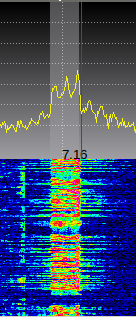
Splattered Signal: This signal is much wider than it needs to be, and much of the energy is not useful.
Running an SDR (or a panadapter in general) on the ham bands is interesting and informative. You learn a lot about how the spectrum is used and the quality of the signals flying around out there. Unfortunately, there are a lot of hams with really bad signals out there, and you see (and hear!) a lot of them.

Splattered Signal: This signal is much wider than it needs to be, and much of the energy is not useful.
This image is from a station running an "Icom" (didn't catch the model number) into a solid state amplifier, with a self-reported output power of 1150W (measurement method unstated, I'd assume PEP). Notice that the primary LSB audio is highly compressed, and that there is both a pronounced USB image and LSB audio extending well into the 5kHz range or higher. (For reference, the red vertical line to the left side of the gray bar on the spectrum scope is 3.3kHz.) You can see the former as energy on the scope display to the right of the primary signal with light blue-to-green horizontal bands on the waterfall below, and the latter as scope energy to the left of the signal and light blue to green horizontal bands below that. Note that there is another signal about 6kHz below the red marker line, that energy is not from the same transmitter.
The FCC requires that the mean power of any transmitter of greater power than 5W in amateur service below 30MHz has no spurious emissions of more than 40dB below the primary emission, and no spurious emissions exceeding 50mW (Part 97, section 307, paragraph (d)). (Older transmitters may be exempt, but certainly not a modern solid-state Icom or linear amplifier!) The measurement tools I had at my disposal at the time this signal was collected are far from precise, but the sideband image of this signal is many dB short of 40dB of attenuation, and the signals from 3kHz to 5kHz in the lower sideband are at least pushing against 40dB down, if not failing to meet it entirely. That's to say nothing of the 50mW requirement, which this amateur is failing to meet by a factor of three or more!
I'm not a big proponent of siccing the FCC on other hams. However, I am a big proponent of knowing what your signal looks like, getting signal reports from reliable third parties, and doing your best to put out clean, neighboring-frequency-friendly transmissions. The lesson we can take away from this is two-fold: One, it's possible to use newly manufactured, type-accepted equipment and generate a poor signal, if there are problems in the setup. It's hard to say what this amateur might be doing wrong; he could be overdriving his solid state amplifier, he could have a poor antenna match, or any number of other problems. Something clearly isn't right, though! Two, people often only know they have a signal problem because someone else notices.
If you happen to notice a dirty signal when you're talking to someone, say something. If someone mentions a bad signal to you, don't take offense — look into it! Remember that sometimes a "bad" signal is caused by an overloaded or misbehaving receiver, so feel free get a second opinion if you're flagged, and be sure to put it gently if you're reporting. Say something like, "your signal appears to have spurious emissions from here, you might want to collect some signal reports from other listeners."
I also don't necessarily recommend butting into a conversation unless the signal is really, really bad -- in this case, the band was relatively lightly used (from here, anyway) and most signals were stronger than this amateur's splatter. I certainly didn't break into the QSO just to say "you have spurious emissions no more than 35dB down," in this case. It's fine to wait until the QSO is over, or let the next contact handle it.
Awareness and conscientiousness are good amateur practices, and they help make the bands more useful for all of us. For my own part, I hope you would tell me if I had a dirty signal, and I promise to take your reports seriously, and with a good attitude. You're only helping me improve my station's performance, after all.